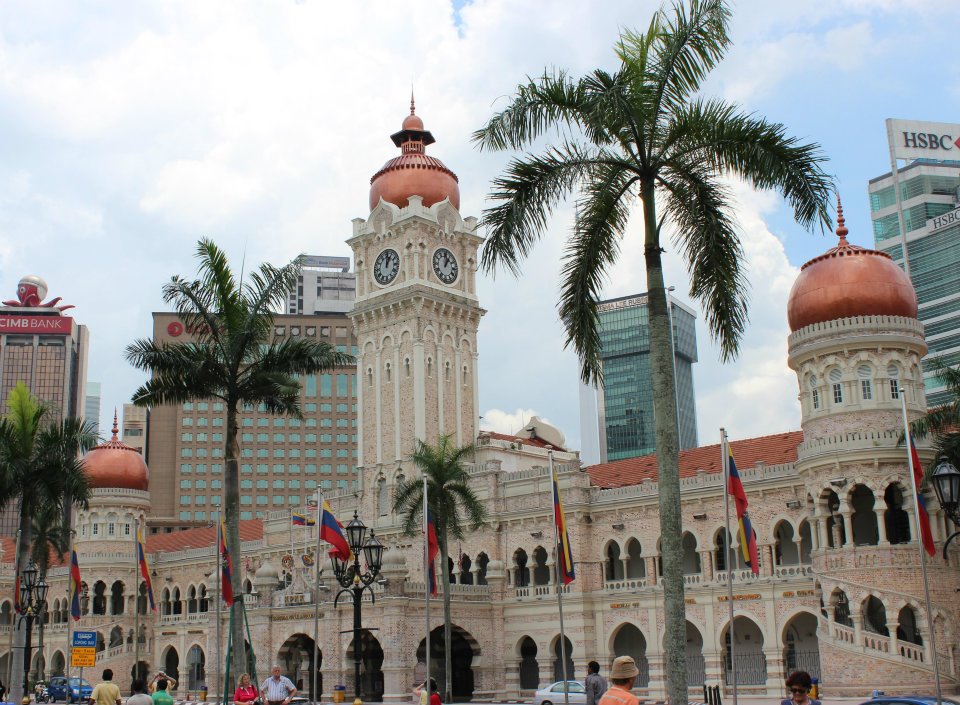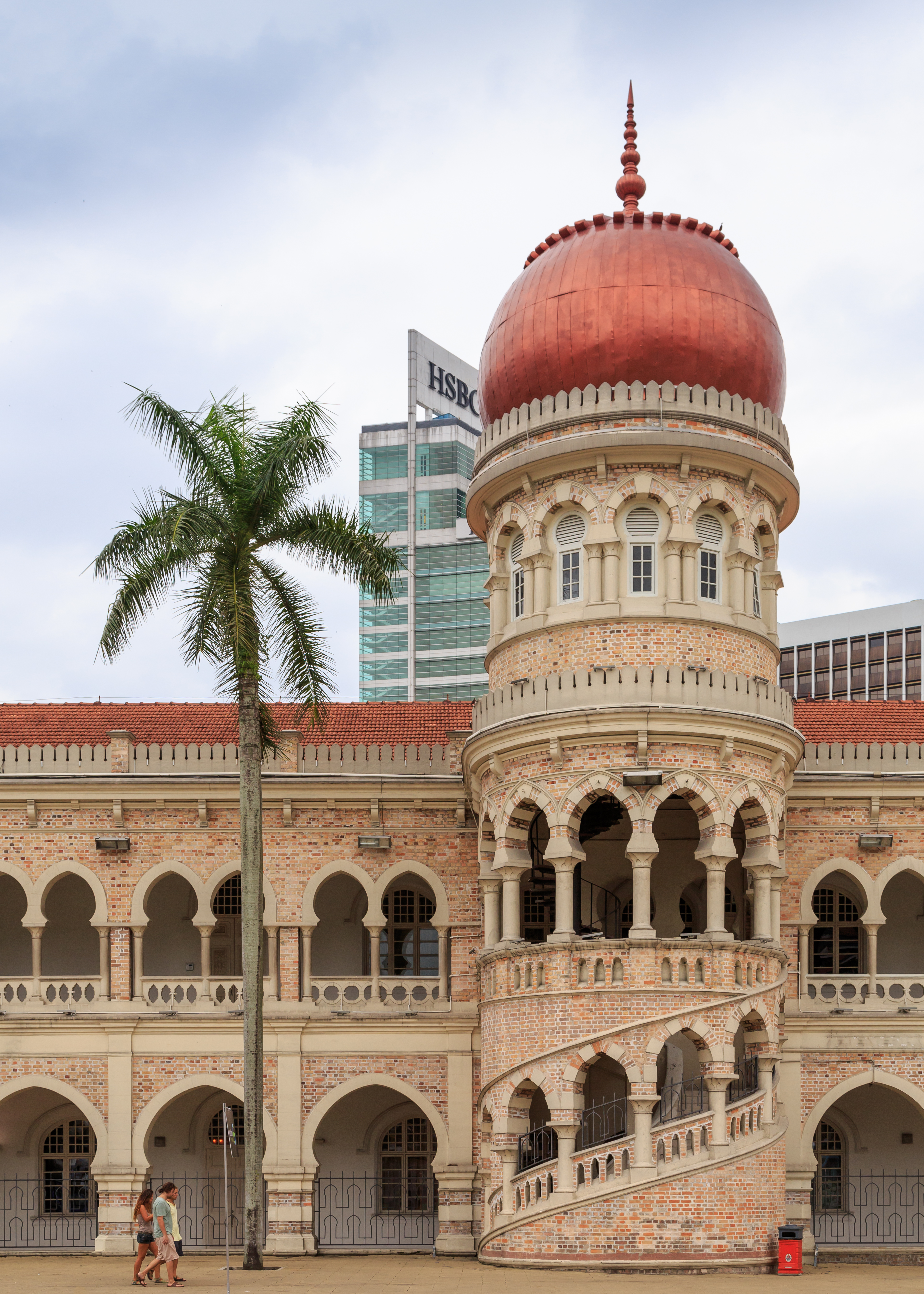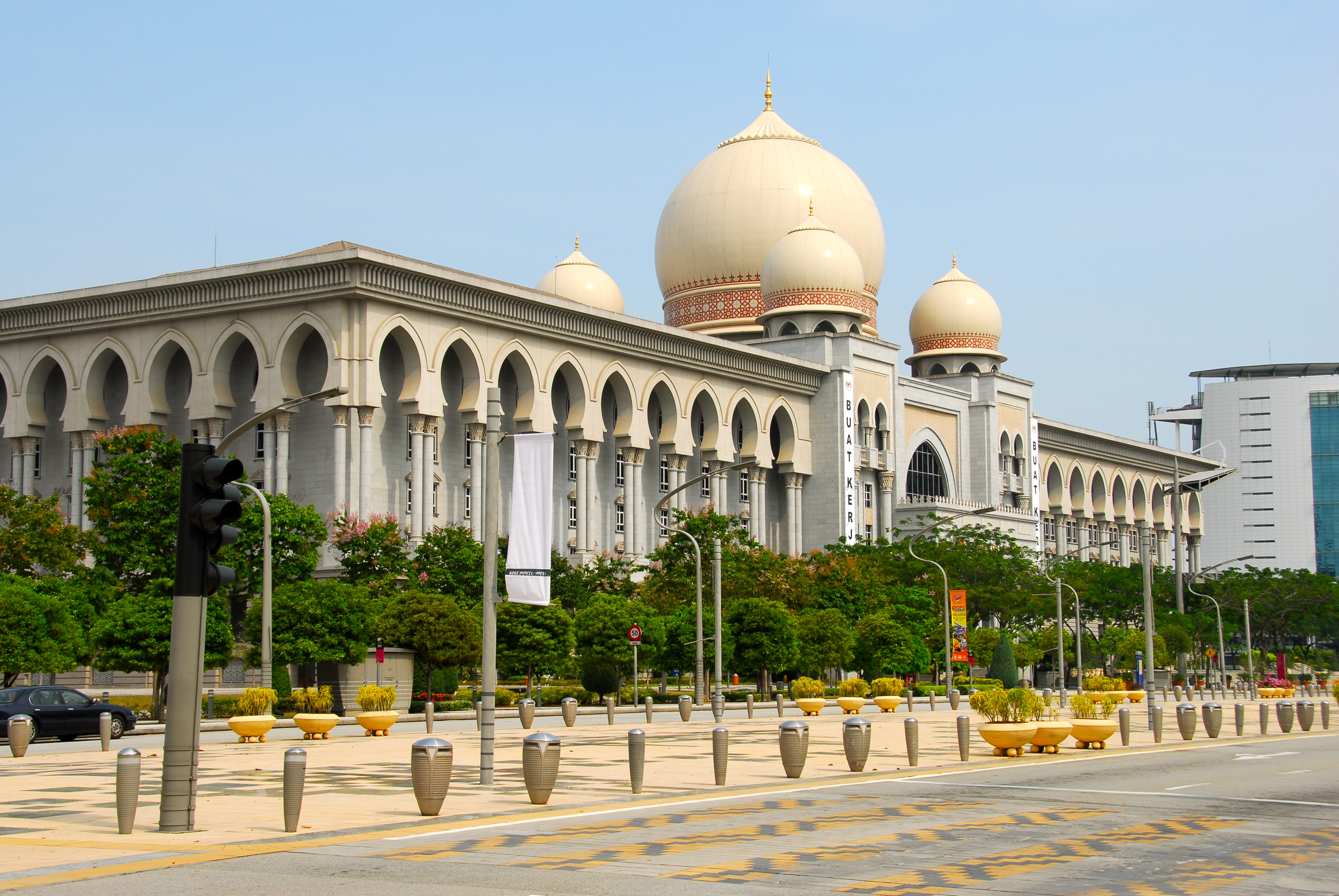|
Former Supreme Court, Kuala Lumpur
The Former Supreme Court Building is the former court house of the Supreme Court of the Federated Malay States in Kuala Lumpur, Malaysia. It was opened in 1915 when the Supreme Court was relocated from Court Hill. History Work commenced on the Supreme Court Building in June 1912 after the old courts situated on Court Hill became inadequate due to the rapid increase in the business of the Court, and took two years and nine months to complete. It was designed by Government architect, Arthur Benison Hubback, and built at a cost of $208,500 Straits Dollars. The contractor was Ang Seng who was the contractor for the nearby Government Offices, now the Sultan Abdul Samad Building. The building was opened by High Commissioner for the Federated Malay States, Sir Arthur Young at a ceremony held on 1 May 1915, in the presence of the Chief Judicial Commissioner Thomas Braddell, judges, court officials and members of the Bar. Later, courts were relocated to the Sultan Abdul Samad Buildi ... [...More Info...] [...Related Items...] OR: [Wikipedia] [Google] [Baidu] |
Kuala Lumpur
Kuala Lumpur (KL), officially the Federal Territory of Kuala Lumpur, is the capital city and a Federal Territories of Malaysia, federal territory of Malaysia. It is the largest city in the country, covering an area of with a census population of 2,075,600 . Greater Kuala Lumpur, also known as the Klang Valley, is an urban agglomeration of 8.8 million people as of 2024. It is among the fastest growing metropolitan regions in Southeast Asia, both in population and economic development. The city serves as the cultural, financial, tourism, political and economic centre of Malaysia. It is also home to the Parliament of Malaysia, Malaysian parliament (consisting of the Dewan Rakyat and the Dewan Negara) and the Istana Negara, Jalan Tuanku Abdul Halim, Istana Negara, the official residence of the King of Malaysia, monarch (''Yang di-Pertuan Agong''). Kuala Lumpur was first developed around 1857 as a town serving the tin mining, tin mines of the region, and important figures such as Ya ... [...More Info...] [...Related Items...] OR: [Wikipedia] [Google] [Baidu] |
Malaysia
Malaysia is a country in Southeast Asia. Featuring the Tanjung Piai, southernmost point of continental Eurasia, it is a federation, federal constitutional monarchy consisting of States and federal territories of Malaysia, 13 states and three federal territories, separated by the South China Sea into two regions: Peninsular Malaysia on the Mainland Southeast Asia, Indochinese Peninsula and East Malaysia on the island of Borneo. Peninsular Malaysia shares land and maritime Malaysia–Thailand border, borders with Thailand, as well as maritime borders with Singapore, Vietnam, and Indonesia; East Malaysia shares land borders with Brunei and Indonesia, and a maritime border with the Philippines and Vietnam. Kuala Lumpur is the country's national capital, List of cities and towns in Malaysia by population, largest city, and the seat of the Parliament of Malaysia, legislative branch of the Government of Malaysia, federal government, while Putrajaya is the federal administrative capi ... [...More Info...] [...Related Items...] OR: [Wikipedia] [Google] [Baidu] |
Arthur Benison Hubback
Arthur Benison Hubback (13 April 1871 – 8 May 1948) was a British Army officer and architect who designed several important buildings in British Malaya, in both Indo-Saracenic architecture and European "Wrenaissance" styles. Major works credited to him include Kuala Lumpur railway station, Ubudiah Mosque, Jamek Mosque, National Textile Museum, Panggung Bandaraya DBKL, Ipoh railway station, and Kowloon railway station (KCR), Kowloon railway station. After an English training in Liverpool, he arrived in Malaya in 1895, and by 1900 was appointed chief government architect of the British-run Federated Malay States, returning to Britain in 1914 at the start of World War I, though he did not officially resign until 1917. Reversing the pattern of many British architects of the British Raj in India, he was an architect who became a soldier, commanding troops in France, and remaining in the army until his retirement in 1924. He was active in sports, especially association football, ... [...More Info...] [...Related Items...] OR: [Wikipedia] [Google] [Baidu] |
Courthouse
A courthouse or court house is a structure which houses judicial functions for a governmental entity such as a state, region, province, county, prefecture, regency, or similar governmental unit. A courthouse is home to one or more courtrooms, the enclosed space in which a judge presides over a court, and one or more Judge's chambers, chambers, the private offices of judges. Larger courthouses often also have space for offices of judicial support staff such as court clerks and deputy clerks. The term is commonly used in the English-speaking countries of North America. In most other English-speaking countries, buildings which house courts of law are simply called "courts" or "court buildings". In most of continental Europe and former non-English-speaking European colonies, the equivalent term is a palace of justice (French: palais de justice, Italian: palazzo di giustizia, Portuguese: palácio da justiça). United States In the United States, most County (United States), c ... [...More Info...] [...Related Items...] OR: [Wikipedia] [Google] [Baidu] |
Indo-Saracenic Architecture
Indo-Saracenic architecture (also known as Indo-Gothic, Mughal-Gothic, Neo-Mughal) was a Revivalism (architecture), revivalist architectural style mostly used by British architects in India in the later 19th century, especially in public and government buildings in the British Raj, and the palaces of rulers of the princely states. It drew stylistic and decorative elements from native Indo-Islamic architecture, especially Mughal architecture, which the British regarded as the classic Indian style. The basic layout and structure of the buildings tended to be close to that used in contemporary buildings in other revivalist styles, such as Gothic revival architecture, Gothic revival and Neoclassical architecture, Neo-Classical, with specific Indian features and decoration added. The style drew from western exposure to depictions of Indian buildings from about 1795, such as those by William Hodges and the Daniell duo (William Daniell and his uncle Thomas Daniell). The first Indo-Sara ... [...More Info...] [...Related Items...] OR: [Wikipedia] [Google] [Baidu] |
Federated Malay States
The Federated Malay States (FMS, , Jawi script, Jawi: ) was a federation of four protectorate, protected states in the Malay Peninsula — Selangor, Perak, Negeri Sembilan and Pahang — established in 1895 by the British government, and which lasted until 1946. In that year they formed the Malayan Union together with two of the former Straits Settlements, (Malacca and Penang), and the Unfederated Malay States. Two years later, the union became the Federation of Malaya, which achieved independence in 1957, and finally Malaysia in 1963 with the inclusion of North Borneo (present-day Sabah), Sarawak and Singapore. Real power in the FMS and its constituent states rested with the four local British Residents and the Resident-General, the discretionary powers of the local Malay Ruler, rulers being essentially reduced to matters "touching Malay Religion and Customs". The federation, along with the Unfederated Malay States of the peninsula and the Straits Settlements, was overrun a ... [...More Info...] [...Related Items...] OR: [Wikipedia] [Google] [Baidu] |
Sultan Abdul Samad Building
The Sultan Abdul Samad Building (Malaysian Malay, Malay: ''Bangunan Sultan Abdul Samad''; Jawi script, Jawi: ) is a late-19th century building located along Jalan Raja in front of Independence Square (Kuala Lumpur), Dataran Merdeka and the Royal Selangor Club in Kuala Lumpur, Malaysia. The building originally housed the offices of the British colonial administration, and was known simply as Government Offices in its early years. In 1974, it was renamed after Sultan Abdul Samad, the reigning sultan of Selangor at the time when construction began. The building houses both the offices of the Ministry of Communications and Multimedia and the Ministry of Tourism and Culture of Malaysia (Malay language, Malay: ''Kementerian Komunikasi dan Multimedia, Kementerian Pelancongan dan Kebudayaan Malaysia''). It once housed the superior courts of the country: the Federal Court of Malaysia, the Court of Appeals and the High Court of Malaya. The Federal Court and the Court of Appeals had shifte ... [...More Info...] [...Related Items...] OR: [Wikipedia] [Google] [Baidu] |
Arthur Young (colonial Administrator)
Captain Sir Arthur Henderson Young (31 October 1854 – 20 October 1938) was a British colonial administrator. Family He was the son of Colonel Keith Young. On 5 November 1885, he married Lady Evelyn Anne Kennedy, a daughter of Archibald Kennedy, 2nd Marquess of Ailsa, and Julia Jephson. Education Young was educated at Edinburgh Academy and the Royal Military College, Sandhurst. Career Young joined the 27th Inniskillings as a sub-lieutenant, and entered the Colonial Service in 1878. He was first appointed to command a Military Police unit in Cyprus. The next 27 years he spent in the colony, holding successively the positions of Assistant Commissioner at Paphos, later Commissioner at Paphos, Commissioner at Famagusta, then Director of Survey and Forest Officer and Chief Secretary to the Government of Cyprus. In 1883 he contested the first elections to the new Legislative Council, but finished last in the Larnaca–Famagusta constituency with only 43 votes of the 6,899 cast. ... [...More Info...] [...Related Items...] OR: [Wikipedia] [Google] [Baidu] |
Thomas De Multon Lee Braddell
Sir Thomas de Multon Lee Braddell (25 November 1856 – January 1927) was a barrister and colonial judge. Early life and education Son of Sir Thomas Braddell, first Attorney General of the Straits Settlements (1867-1882), Thomas de Multon Lee Braddell was born in Province Wellesley on 25 November 1856. He was educated at Brighton College, and Worcester College, Oxford. In 1879 he was called to the bar of the Inner Temple. Career In 1879, Braddell went to Singapore to join his father's law firm, and in the following year was admitted to the local bar. In 1883, he founded the firm Braddell Brothers with his brother Robert Braddell, today the second-oldest law firm in Singapore. Except in 1898, when he briefly acted as Attorney General, he continued in private practice until 1907 when he was appointed Puisne Judge, and in 1911, following his father, he was appointed Attorney General. In 1913, he went to Kuala Lumpur as Chief Judicial Commissioner of the Federated Malay States ... [...More Info...] [...Related Items...] OR: [Wikipedia] [Google] [Baidu] |
Palace Of Justice, Putrajaya
The Palace of Justice (, Jawi script, Jawi: ) houses the Malaysia, Malaysian Court of Appeal of Malaysia, Court of Appeal and Federal Court of Malaysia, Federal Court, which moved to Putrajaya from the Sultan Abdul Samad Building in Kuala Lumpur in 2003. History Due to the need for a proper office of the head of the judicial system in Malaysia, a location within the Precinct 3 of Putrajaya was identified for this purpose. aQidea Architect was commissioned to design the building after finishing the nearby Perdana Putra, Prime Minister's Office. The building houses two Federal Courts, six Courts of Appeal, the Chief Registrar's Office, two registries for the Federal Court, the Court of Appeal (as required under Articles 121(1B) and 121(2)), a conference hall, a library, and a museum. The complex has an intricate network of passages which segregate the judges, witnesses, public, and the accused leading to the courts from the car park or area of arrival. The design is about bringi ... [...More Info...] [...Related Items...] OR: [Wikipedia] [Google] [Baidu] |
Kuala Lumpur City Hall
The Kuala Lumpur City Hall (, Abbreviation, abbreviated DBKL or KLCH) is the city council which administers the city of Kuala Lumpur in Malaysia. This council was established after the city was officially granted city status on 1 February 1972. Their jurisdiction covers an area of 243 square kilometres. The council consists of the mayor plus fifteen members of the city advisory board appointed to serve a one-year term by the Ministry of Federal Territories (Malaysia), Minister of Federal Territories. The current mayor of Kuala Lumpur is Maimunah Mohd Sharif, who has been in office since 15 August 2024. History The agency was formerly known as Kuala Lumpur Municipal Council formed in 1948 to take over the role of Kuala Lumpur Sanitary Board.(Malay language, Malay: ''Majlis Perbandaran Kuala Lumpur''). During British colonial times and early independence, Kuala Lumpur had been the capital of the country as well as the state of Selangor. On 1 April 1961, the name changed into K ... [...More Info...] [...Related Items...] OR: [Wikipedia] [Google] [Baidu] |
Independence Square (Kuala Lumpur)
Independence Square () is a square located in Kuala Lumpur, Malaysia. It is situated in front of the Sultan Abdul Samad Building. It was formerly known as the Selangor Club Padang, or simply the ''Padang'' (meaning "field" in Malay), and was used as the cricket green of the Selangor Club (now the Royal Selangor Club). It was here that the Union Flag was lowered and the Malaysian flag hoisted for the first time at midnight on 31 August 1957. Since then, the Independence Square has been the usual venue for the annual Independence Day Parade. History In the early days of Kuala Lumpur, the Chinese and Malay communities settled along the east bank of the Klang River. To the west of the river was land originally owned by Yap Ah Loy and was used to plant vegetables. In 1880, the state capital of Selangor was moved from Klang to Kuala Lumpur by the colonial administration. The then British Resident William Bloomfield Douglas decided that the government buildings and staff livin ... [...More Info...] [...Related Items...] OR: [Wikipedia] [Google] [Baidu] |






